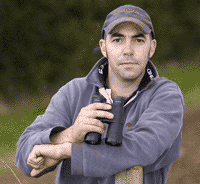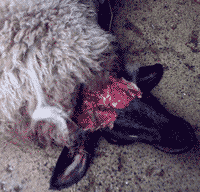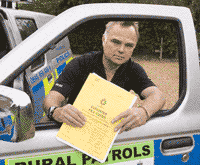The Great Big Cat Hunt

Rumours abound that big cats prowl the British countryside. But are they really out there or the product of over-active imaginations? Tim Relf wraps up warm and waits for the fur to fly
READ ON THIS PAGE:
- Tim’s account of a night hunting for the Beast of St Neots with FW News editor Jon Riley
- Genuine Police reports of sightings
- Eye-witness accounts from Leicestershire, Rutland and the Pennines
- And when you’ve taken a look, let us know about your big cat sightings and share your views on our forums
But first, watch our video of Tim’s night spent looking for the creature that has left a trail of devastation across a Cambridgeshire farm.
On the trail of the Beast
It’s the middle of the night and I’m in the middle of a field in the middle of nowhere. I’m scared and I don’t mind admitting it.
 |
|---|
| “I’ve seen sheep killed by dogs – but never anything like this before” – Cambridgeshire farmer Colin Crane. |
This is, after all, the exact spot where four days before a sheep was attacked by what the farmer, Colin Crane, is convinced is a marauding big cat. And, exactly a week before that, another of his sheep was savaged nearby.
The first had its stomach ripped open, the top of its head mutilated. Dead on the spot. The second survived briefly, then died: Its carcass clearly shows what look like teeth marks and tears. At both spots, wool is still strewn around – tellingly, with large clumps of skin attached.
 |
|---|
| Mutilated – and dead on the spot. One of Colin’s sheep. |
“A dog wouldn’t have broken the skin like that,” Colin tells me as he leads us to the field where we’re due to pitch camp.
“A badger wouldn’t tackle lambs that big – they were 35 or 40kg. I can’t get my fingers across the two canine marks that were on the back leg of the second one,” he says. “Even a rottweiller can’t get its canines that far apart.
“I’ve seen sheep killed by dogs – but I’ve never seen anything like this before,” says Colin.
We’re near St Neots in Cambridgeshire – in the centre of a large area where there have been hundreds of sightings of so-called big cats in recent years.
| THE FARMER’S STORY Andy Holland is one of the few who reckons he’s seen a big cat with a cub. It was the end of a day harvesting. He heard a rustling, shone a spotlight on the source of the noise and there they were. The big one was jumping the straw swaths, the cub was blundering through them, says Andy, who farms at Twyford in Leicestershire. “The cub was mottled and spotted and had a short little tail like a loo brush. They headed into a ditch.” Since then a few members of the Holland family have spotted big cats, and there has been a host of sightings by other people in the area. He’s also found sheep carcasses that seemingly corroborate his theory. “One was that cleanly licked, it was as if someone had operated on it. All the bones were |
|---|
I’ve got an open mind on the subject. I reckon I’m streetwise enough not to be taken in by hoaxers and I’m not a nutter (I like to think), but the suggestion that animals such as panthers, lynx and pumas are living – and possibly breeding – in the wild does seem a credible one.
My colleagues – FW news editor Jon Riley and photographer Jonathan Page – are with me, but that’s not a whole lot of comfort when you see photos of these creatures and read what they’re capable of. Yes, I know there have been no reported attacks on humans in Britain – but the fact of the matter is they are big enough and fast enough and powerful enough to tear a person to pieces.
I must be a little mad then, I think, to be actually spending a night outside. Maybe my idea to come armed with a big bag of bones freshly collected from a local farm shop – “beast bait”, as we refer to it – in a bid to lure the animal isn’t such a good idea.
The guy who supplied us with the bones is sceptical. He promised to give me £100 if we captured the creature on camera. Similarly, news editor Jon is dubious about the whole endeavour. “Somewhere between flying pigs and the Loch Ness monster,” is where he places big cats on the believability scale.
Yet beneath this certainty, he had a chink of doubt. “What if the two dead lambs had been killed by a monster cat?” he asked, as we drove to Cambridgeshire. “What if it is out there just waiting to be spotted and in a million-to-one shot we came back with the proof?”
 |
|---|
| POLICE FILE FW got access to PC Paul Carter’s file at Cambridgeshire Police. Here is a selection of the comments people have made:
|
“It was so strange,” Colin recalls, as we settle in for the evening. “The sheep were going round and round in circles after the attack. They were so nervous, so scared – they were like a shoal of fish, all trying to get into the middle.
“The way it appears to have dragged them down and looking at how big the marks are – this could be a panther or a cougar.”
If it had been one dead sheep, Colin might have overlooked it. Two, he’s sure, is no coincidence. “I’ve always thought these animals were out there – now I’m sure.”
His initial excitement and curiosity soon turned to worry. “Then I thought: I can’t afford to lose too many animals – and I lamb all my sheep outside. Plus I thought: sh*t, this happened quite close to our house. At the moment, it’s livestock – but what if it’s someone’s cat or dog or, heaven forbid, their child?”
It’s early evening. Our tent is up. We make a cuppa. Our plan is simple – stake out the spot and try and get video evidence of a big cat. It’s moonless, cloudy, cold. We’ve got infrared video kit, high-tech cameras, powerful torches, binoculars. Night falls and we acclimatise to the dark, lay out the bait, set up the equipment.
I’m sure the experts wouldn’t approve of what we we’re doing. I mean, they tell you to avoid these creatures, not go out courting them. Over the years, I’ve seen photos of sheep supposedly attacked by them – torn open, stripped clean. A farm animal – a person – would be like a ragdoll in one of these animal’s jaws.
Sightings have become so widespread that the police have become interested. PC Paul Carter, a Wildlife Officer with Cambridgeshire Police, has amassed a thick file of sightings.
“Everything from what sounds like Scottish wild cats to panthers and everything in between,” he says.
He’s prepared to admit that people’s minds do occasionally play tricks on them, but has been contacted by dozens of members of the public who are “absolutely convinced” they’ve encountered one of these creatures.
The main area, he says, covers a “banana-shaped slab of land”, running west of the A1, from Wansford, past St Neots – where we’re camping out – and Huntingdon, around as far as Ely.
Paul’s keeping an open mind himself. “It sounds plausible – but the information is sketchy. Plus, why haven’t any carcasses been found?” he asks.
| SARAH’S STORY
It took me a few seconds to realise I was awake and seeing what I thought I was seeing. There, running in front of my car was what I can only describe as a large black cat, the size of a collie dog. It happened about five o’clock one morning last August as I was heading home from Newcastle airport. I must have been about 1.5 miles from Allendale, a village in the North Pennines. The cat was in the middle of the road and, as it saw my car, it turned its head and started running forward. Because the road was boxed in by stone walls and steep banks, it had to run for a couple of minutes before darting into a hedge at the first opportunity. |
If these creatures are out there, one explanation is that they’ve been smuggled into Britain and then either escaped, or been turned loose by people who realise how difficult they are to keep or whom guilt has got the better of, he says. “The exotic pet trade is big, big money.”
Before the law controlling imports changed in the 1970s, animals such as lynx and puma were brought into the country to be kept in private collections, too. Some suggest the descendants of these animals are now living – and breeding – wild.
Back at our camp, we do a first recce, walk around the field. We’re nervous. I try to keep in mind one of PC Carter’s points – that, like any wild animal that bites or stings, it only does it if it’s threatened. There again, his general advice to the public is: “If you see anything like this, don’t approach it.” And here we are, going out of our way to do exactly that.
It’s not as if we’re in any position to defend ourselves. We don’t have guns (all the advice is that you shouldn’t tackle these animals). I repeat over and over in my mind the advice I’d been given. Don’t run away as this could trigger an attack. Keep your eyes on the animal and walk slowly away backwards.
It occurs to me at this point it’s probably not sensible standing where I am – under a tree. There have been reports of sheep carcasses dragged high into trees.
There’s not much sound. It gets late. I’m used to being outside at night and hearing country noises, but I’m on edge. Seriously on edge. The three of us are trying to put on a brave face, joke about this, laugh, but it’s all bravado. Your mind plays tricks on you. Your eyes do, too. Our sense or bravado begins to disappear. This is serious.
We walk the fields intermittently, check the bones, walk the fence line, stake out key spots – at one of which there is a strange, musty smell (I learn later that big cats have a very strong smell).
When we hear noises, we summon our courage and investigate – at one point racing across a field in the dark towards a spot where there was something moving behind a hedge. It turns out to be a fox.
We spend a lot of time observing the gateway between two fields where the farmer Colin is convinced the “ambush” took place. It’s seems a plausible spot: There are lots of woods in the vicinity, a brook, a network of ditches, plenty of hedge cover. It’s true what he said: The sheep – even now – seem reluctant to go back through the gateway. “Something definitely happened there,” he said.
We sleep a bit. Watch a bit more. Morning arrives. We head out again. The bones are untouched. The cameras have recorded nothing. I’m disappointed, but slightly relieved too. I’m not sure how I would have reacted if I had found myself face to face with one of these beasts.
We have a debrief. My colleague Jon Riley reckons the previous 24 hours – a couple of things he’d seen and heard, in particular – had changed his mind. “First off, meeting Colin,” he says. “I had expected to meet some barking star-gazer type, but he was a sensible, rational bloke who knew a lot about the countryside and his two dead lambs bore some savage injuries. The marks were delivered by something agile that led with its claws.
“I won’t be certain, of course, until I’ve seen a big cat in the UK countryside with my own eyes. But the possibility that they are out there somewhere has gone way up my believability scale.”
As for me? Well, I’m certainly far less of a sceptic than I was 24 hours before. It’s been a bit like piecing together a jigsaw puzzle. None of the “evidence”, in itself, conclusively proves the existence of these animals – but collectively it presents a convincing case.
I ring my farmshop friend and tell him his £100 is safe. “I never doubted it wouldn’t be,” he replies.
| THE MONITORING GROUP One person who has absolutely no doubt that big cats are out there is Nigel Spencer, who co-founded Rutland and Leicestershire Panther Watch with his father, David. Their interest was sparked when David made a sighting in the mid-1990s. Once they launched the group, people began coming out of the woodwork – saying “No one believes me, but…” Over the years, sightings have flooded in. Nigel’s now had over 1000 in his area. Sightings, he says, often come from “credible sources”, like farmers and gamekeepers. “These people know what they’re talking about – they know what they’re looking at. It’s insulting for them to be told it was a fox they saw. “It can be a life-changing experience when someone spots one of these animals,” he says. Nigel, an engineer working in the food sector, has seen a puma in Essex. “Imagine an Afghan hound… it was that size. It was a light sandy yellowƒ completely different to a fox or a deer. Other sightings of the same creature came in later, tallying with mine.” He admits the case is weakened by the lack of carcasses, but says it’s not surprising as these animals are so secretive and “street-wise”. |
|---|
- Do you reckon these animals are out there, or is the idea preposterous? Join the debate and share your sightings on our dedicated forum thread.
- This is an abridged version of an article which will appear in the 24 October issue of Farmers Weekly.

 licked clean, and the fat off the inside of the skin was licked clean.”
licked clean, and the fat off the inside of the skin was licked clean.”  Sarah Trickett, FW livestock reporter
Sarah Trickett, FW livestock reporter